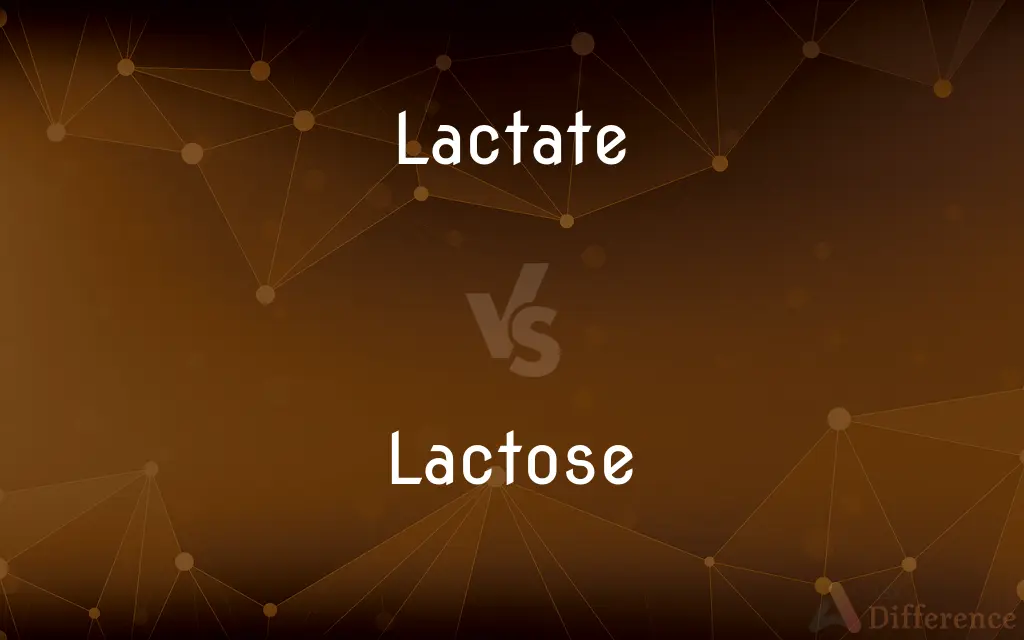Lactate vs. Lactose — What's the Difference?
Edited by Tayyaba Rehman — By Fiza Rafique — Updated on March 4, 2024
Lactate is a compound produced during anaerobic respiration, while lactose is a sugar found in milk and dairy products.

Difference Between Lactate and Lactose
Table of Contents
ADVERTISEMENT
Key Differences
Lactate, a byproduct of anaerobic respiration, is produced when the body breaks down carbohydrates for energy without enough oxygen, commonly occurring during intense exercise. On the other hand, lactose is a disaccharide sugar composed of glucose and galactose, primarily found in milk and dairy products, serving as an important energy source.
While lactate plays a crucial role in metabolism and energy production, especially under conditions where oxygen is scarce, lactose is significant in nutrition, particularly for infants, as it provides essential calories and carbohydrates for growth and development. This distinction highlights their different roles in biological processes and human diet.
Lactate is a simpler molecule, existing in two forms (L-lactate and D-lactate) based on its optical activity, reflecting its metabolic origin. Lactose, however, is more complex, requiring the enzyme lactase for its digestion into simpler sugars that can be absorbed by the body. This difference in digestion and metabolism underscores their distinct biological and nutritional functions.
The production of lactate during strenuous physical activities can lead to muscle fatigue and soreness, a temporary condition often associated with intense workouts. Whereas, the consumption of lactose by individuals with lactose intolerance can cause digestive discomfort, such as bloating, diarrhea, and gas, due to the lack of sufficient lactase enzyme to break down lactose.
Lactate is often monitored to assess physical fitness and metabolic conditions, as elevated levels can indicate various health issues beyond normal muscle fatigue. Conversely, lactose intake is a dietary consideration, particularly for those with lactose intolerance or seeking to manage dairy consumption for health reasons, emphasizing their relevance in health and nutrition discussions.
ADVERTISEMENT
Comparison Chart
Definition
A compound produced during anaerobic respiration.
A sugar found in milk and dairy products.
Primary Role
Involved in energy production under low oxygen conditions.
Provides essential calories and carbohydrates for growth.
Chemical Structure
Simpler molecule, exists as L-lactate and D-lactate.
Disaccharide sugar composed of glucose and galactose.
Digestion & Metabolism
Produced and utilized within the body's metabolic processes.
Requires digestion by the enzyme lactase to be absorbed.
Health Considerations
Associated with muscle fatigue and metabolic conditions.
Consumption can cause digestive discomfort in some individuals.
Compare with Definitions
Lactate
Indicator of metabolic conditions.
Elevated lactate levels can signal metabolic or respiratory issues.
Lactose
Provides energy and calories.
Lactose is an important dietary component for infants.
Lactate
Present in two forms.
L-lactate is the form predominantly produced in human metabolism.
Lactose
A sugar in milk and dairy.
Lactose gives milk its slightly sweet taste.
Lactate
Associated with muscle fatigue.
Accumulation of lactate in muscles can lead to soreness post-exercise.
Lactose
Composed of glucose and galactose.
Lactose is broken down into these simpler sugars for absorption.
Lactate
A byproduct of anaerobic respiration.
High levels of lactate can indicate intense physical exertion.
Lactose
Requires lactase for digestion.
Individuals lacking lactase experience lactose intolerance.
Lactate
Involved in energy production.
Lactate is utilized by muscles for energy during oxygen-limited activities.
Lactose
Can cause digestive issues.
Lactose intolerance leads to symptoms like bloating and diarrhea.
Lactose
Lactose is a disaccharide. It is a sugar composed of galactose and glucose subunits and has the molecular formula C12H22O11.
Lactose
A white crystalline disaccharide, C12H22O11, found in milk, that may be hydrolyzed to yield glucose and galactose. Refined lactose obtained from whey is used in infant foods, bakery products, confections, and pharmaceuticals as a diluent and excipient. Also called milk sugar.
Lactose
(carbohydrate) The disaccharide sugar of milk and dairy products, C12H22O11, a product of glucose and galactose used as a food and in medicinal compounds.
Lactose
The main sugar present in milk, called also sugar of milk or milk sugar. When isolated pure it is obtained crystalline; it is separable from the whey by evaporation and crystallization. It is a disaccharide with the formula C12H22O11, being chemically 4-(
Lactose
A sugar comprising one glucose molecule linked to a galactose molecule; occurs only in milk;
Cow's milk contains about 4.7% lactose
Common Curiosities
What happens to lactate after intense exercise?
Lactate can be converted back into energy or cleared from the body, reducing muscle soreness over time.
What is the main difference between lactate and lactose?
Lactate is a metabolic byproduct of anaerobic respiration, while lactose is a disaccharide sugar found in milk.
What role does lactose play in the dairy industry?
Lactose influences the taste, texture, and nutritional value of dairy products.
Can lactate be found in dairy products?
No, lactate is produced by the body during anaerobic metabolism, not found in dairy products.
Is lactate harmful?
While high levels can indicate health issues, lactate itself is a normal and important part of the body's energy processes.
Can everyone digest lactose efficiently?
No, some people lack enough lactase enzyme, leading to lactose intolerance.
How is lactose intolerance managed?
By limiting or avoiding lactose-containing foods or taking lactase enzyme supplements.
Why is lactose important in infant nutrition?
Lactose provides essential energy and supports the development of the infant's brain and body.
Is lactose present in all dairy products?
Most dairy products contain lactose, but some, like certain cheeses and lactose-free milk, have lower levels.
Can lactate be used as a fuel by the body?
Yes, the body can convert lactate back into energy, especially in the liver through gluconeogenesis.
How are lactate levels measured?
Through blood tests, often used to assess fitness levels or diagnose medical conditions.
How does lactose content vary among dairy products?
Lactose content varies, with milk having higher levels and fermented products like yogurt and certain cheeses having lower levels due to bacterial digestion of lactose.
What is the significance of lactate in clinical diagnostics?
Elevated lactate levels can indicate tissue hypoxia, sepsis, or other conditions, making it important in clinical diagnostics.
What are the symptoms of lactose intolerance?
Symptoms include bloating, diarrhea, gas, and abdominal discomfort after consuming lactose.
Are there any health benefits to lactate production?
Lactate production is crucial for energy supply during oxygen-limited situations, supporting muscle function.
Share Your Discovery

Previous Comparison
Opaque vs. Translucent
Next Comparison
Intervention vs. TreatmentAuthor Spotlight
Written by
Fiza RafiqueFiza Rafique is a skilled content writer at AskDifference.com, where she meticulously refines and enhances written pieces. Drawing from her vast editorial expertise, Fiza ensures clarity, accuracy, and precision in every article. Passionate about language, she continually seeks to elevate the quality of content for readers worldwide.
Edited by
Tayyaba RehmanTayyaba Rehman is a distinguished writer, currently serving as a primary contributor to askdifference.com. As a researcher in semantics and etymology, Tayyaba's passion for the complexity of languages and their distinctions has found a perfect home on the platform. Tayyaba delves into the intricacies of language, distinguishing between commonly confused words and phrases, thereby providing clarity for readers worldwide.














































